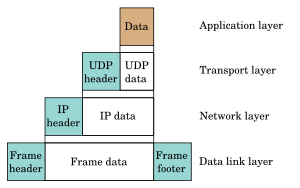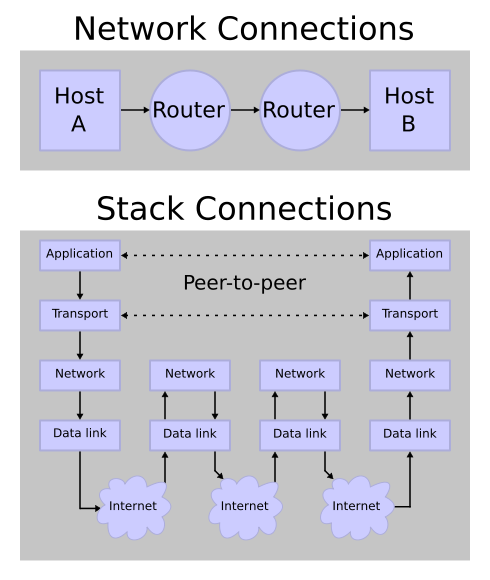
The Internet protocol suite is the set of communications protocols that implement the protocol stack on which the Internet and most commercial networks run. It has also been referred to as the TCP/IP protocol suite, which is named after two of the most important protocols in it: the Transmission Control Protocol (TCP) and the Internet Protocol (IP), which were also the first two networking protocols defined. Today’s IP networking represents a synthesis of two developments that began in the 1970s, namely LANs (Local Area Networks) and the Internet, both of which have revolutionized computing.
The Internet Protocol suite—like many protocol suites—can be viewed as a set of layers. Each layer solves a set of problems involving the transmission of data, and provides a well-defined service to the upper layer protocols based on using services from some lower layers. Upper layers are logically closer to the user and deal with more abstract data, relying on lower layer protocols to translate data into forms that can eventually be physically transmitted. The TCP/IP reference model consists of four layers

The Internet protocol suite came from work done by DARPA in the early 1970s. After building the pioneering ARPANET, DARPA started work on a number of other data transmission technologies. In 1972, Robert E. Kahn was hired at the DARPA Information Processing Technology Office, where he worked on both satellite packet networks and ground-based radio packet networks, and recognized the value of being able to communicate across them. In the spring of 1973, Vinton Cerf, the developer of the existing ARPANET Network Control Program (NCP) protocol, joined Kahn to work on open-architecture interconnection models with the goal of designing the next protocol for the ARPANET.
By the summer of 1973, Kahn and Cerf had soon worked out a fundamental reformulation, where the differences between network protocols were hidden by using a common internetwork protocol, and instead of the network being responsible for reliability, as in the ARPANET, the hosts became responsible. (Cerf credits Hubert Zimmerman and Louis Pouzin [designer of the CYCLADES network] with important influences on this design.)
With the role of the network reduced to the bare minimum, it became possible to join almost any networks together, no matter what their characteristics were, thereby solving Kahn’s initial problem. One popular saying has it that TCP/IP, the eventual product of Cerf and Kahn’s work, will run over "two tin cans and a string." There is even an implementation designed to run using homing pigeons (Request for Comments 1149), . This implementation is documented in.
A computer called a router (a name changed from gateway to avoid confusion with other types of gateway) is provided with an interface to each network, and forwards packets back and forth between them. Requirements for routers are defined in (Request for Comments 1812)
The idea was worked out in more detailed form by Cerf’s networking research group at Stanford in the 1973–74 period, resulting in the first TCP specification (Request for Comments 675). (The early networking work at Xerox PARC, which produced the PARC Universal Packet protocol suite, much of which was contemporaneous, was also a significant technical influence; people moved between the two.)
DARPA then contracted with BBN Technologies, Stanford University, and the University College London to develop operational versions of the protocol on different hardware platforms. Four versions were developed: TCP v1, TCP v2, a split into TCP v3 and IP v3 in the spring of 1978, and then stability with TCP/IP v4 — the standard protocol still in use on the Internet today.
In 1975, a two-network TCP/IP communications test was performed between Stanford and University College London (UCL). In November, 1977, a three-network TCP/IP test was conducted between the U.S., UK, and Norway. Between 1978 and 1983, several other TCP/IP prototypes were developed at multiple research centres. A full switchover to TCP/IP on the ARPANET took place January 1, 1983.
The IP suite uses encapsulation to provide abstraction of protocols and services. Generally a protocol at a higher level uses a protocol at a lower level to help accomplish its aims. The Internet protocol stack has never been altered, by the IETF, from the four layers defined in RFC 1122. The IETF makes no effort to follow the seven-layer OSI model and does not refer to it in standards-track protocol specifications and other architectural documents.
{via wikipedia}







